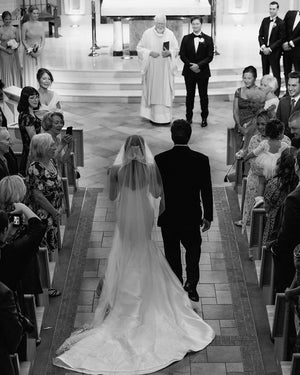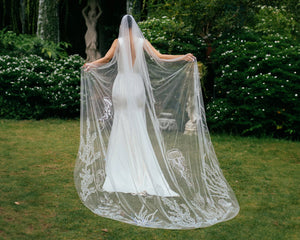You may also like
For thousands of years, women have worn veils, particularly in religious contexts, such as when attending church. The veil, a cloth meant to cover the head or face, has held various meanings across cultures, often symbolizing modesty, respect, and religious devotion.
Spanning multiple civilizations, from ancient Mesopotamia to early Christianity, the practice of women wearing a veil to church/worship has origins deeply intertwined with diverse religious, cultural, and personal beliefs. In some religious sectors, this practice is still held today.
In this blog, we’ll be going into the history of wearing a veil to church (and other places of worship) so we can better understand the variety of ways veils have been used as a form of expression throughout history. Honor these timeless traditions with a handcrafted veil from Tara Bridal. Visit https://tarabridal.com/ to discover our collection of spiritually-inspired veils.

Bride: Kaitlyn Stoll, OH USA. Photo: Megan Jo. Veil: Rebecca from Beaded wedding veils
Ancient History of the Veil
Around 2000 BCE, veiling was documented in ancient Mesopotamia, two millennia before the concept of “church” existed. Texts like the Code of Hammurabi indicate that upper-class women were required to veil as a sign of status, while those of a lower class status were forbidden to do so. In Assyria, only respectable women of high social rank could wear veils in public. Browse through our elegant cathedral veils that embody the grace of ancient traditions. These laws strictly distinguished between free women and those of a lower class, with veils acting as symbols of dignity and protection from male attention which was only afforded to the elite.

An ancient Rome wedding. source: SPQR | Ancient Rome and the Ancient World
In the societies of ancient Greece and Rome, veiling was used as a symbol of modesty and an ideal womanhood, especially for married women. Greek women, especially those of higher status, wore veils when they left their homes, covering their heads and faces to express their marital status. In Rome, a bride would wear a red or orange veil called a flammeum during her wedding to symbolize her transition to married life. Roman matrons, or married women, often covered their heads with a veil called a palla when in public, signifying respectability and devotion to their husbands.
The Symbolism of the Veil
While the tradition of women wearing veils to church has evolved, its symbolism retains deep meaning for many. Historically, the veil has been seen as a symbol of modesty, purity, and reverence, especially within the context of worship. By covering her head, a woman may acknowledge the authority of God, humbling herself before the divine. This act is not only about modesty but also about reverence, offering a tangible reminder of one’s spiritual devotion.
The veil also served as a symbol of protection, creating a barrier between the individual and the outside world. It helps to shield the wearer from distractions, allowing them to enter a sacred space in a focused, contemplative manner, establishing a mental and spiritual boundary as they prepare to engage in worship.
Furthermore, for some, headcovering represents a woman’s spiritual commitment. It is an outward expression of inward faith, a visible sign of reverence and worship. For women in the Church, the act of veiling is not only a physical gesture but a deeply spiritual practice. It affirms their role within the community of faith. It serves as a constant reminder of the sanctity of worship and the sacred nature of their relationship with God.
Wedding Veil In Religious Traditions
Religious traditions have a diverse range of forms and meanings they attach to the wearing of a veil during worship. Commonly across many faiths as part of religious identity and community practice, wearing a veil can reinforce one’s sense of belonging and heritage. It may signify adherence to specific religious teachings and values, helping individuals identify themselves as part of a religious community. Veiling most often occurs within communal settings, such as places of worship or during religious events. This shared practice fosters a sense of unity among members of these communities.
For Christian denominations which still carry the practice, it carries rich symbolism rooted in biblical teachings, modesty, and reverence for the divine. The significance of the veil in Christianity reflects centuries of devoted worship and tradition. This practice is particularly present in Catholicism, Eastern Orthodoxy, and some branches of Anglicanism.
Within these traditions, women will wear veils or head coverings as an outward expression of their humility before God, following the guidance of St. Paul, who discusses head coverings as a sign of respect and submission to God during worship in the New Testament. This symbolism can enhance the emotional and spiritual significance of the worship experience.

Bride: Paulina Leal - Zapopan, Mexico. Photo: danielagtzh.com. Veil: Lilly from Floral veils
In Judaism, wearing veiling for ladies is a practice primarily observed in Orthodox and traditional communities. In ancient Israel, veiling was a widespread practice symbolizing modesty and often for women their marital status. In these communities, the tradition of covering one’s hair is practiced today as well, where married women wear headscarves (tichel), hats, or wigs (sheitel) to cover their hair in public as a sign of respect, modesty, and dedication to their marital relationship. Veils are also still used in a religious context in a number of Jewish weddings. In the Bedeken marriage ceremony, the groom places the veil over the bride’s face, typically before the chuppah (wedding canopy). It is when a groom looks at his bride and ensures he's marrying the right person.
For a Jewish groom, the act of veiling his bride represents an emphasis on her inner qualities and virtues. It serves as a reminder that marriage transcends physical appearance, highlighting the importance of a deep spiritual bond. In the orthodox Jewish interpretation, a woman's hair is considered a private aspect of her beauty, and covering it in public is seen as a sign of modesty and respect for her marriage. This practice, however, differs from wearing veils specifically in a church, which is more commonly found in Catholic or highly conservative Christian faith traditions. To delve into the meaning of veiling in the Catholic tradition and what it means for women today, take a look at this thought-provoking discussion from the 'Dear Edith' blog.
In the early Catholic tradition, veiling is a reminder of the spousal relationship between Christ and the Church. The Catholic veil is also a reminder of the sanctity and dignity of women. Within marriage, the popular conception of wearing a chapel veil was as a visualization of a woman’s submission to a man within their marriage. As the years went by, however, chapel veils slowly stopped becoming a symbol of subservience. Instead, the Catholic chapel veil is now used to cover something that we consider important. Meaning that the purpose of wearing a wedding veil specifically has now shifted from being a symbol of servility to protecting something that is cherished, respected and adored.
In Catholic weddings that are organized in a church, the veil is intended to enhance the bride’s modesty, and protect her from outside distractions and harm. Many Catholic churches require the bride's shoulders to be covered during the ceremony, often done with a sleeved dress or lace from a mantilla veil. Alternatively, some brides wear the veil draped over the back of their head and shoulders. The bride may walk down the aisle with the veil over her face, and the groom lifts it at the altar.
In the late 19th and early 20th centuries, veiling in the West became less common as fashion trends shifted. However, veils continued to be used in specific contexts, such as mourning attire, where black veils symbolize grief, or at formal events like weddings, where bridal veils represented purity and new beginnings. However, no one is absolutely sure of the history of wedding veils, as not everything was always deemed important enough to be preserved or written down in ancient times. Most experts can agree on one thing: “You can trace its (veiling’s) roots back to Rome, where a bride used to walk down the aisle with a veil over her face in order to disguise herself from any evil spirits who wanted to stand in the way of her happiness,” said custom wedding veil creator Samantha Stark. In time, wedding veils became symbols of a bride's chastity and modesty, an idea which has endured for many people even to this day.
Wedding Veil In Modern Society
In our modern age, wedding veils hold different meanings for various brides. Some view them as a lovely accessory that enhances their wedding dress, while others choose to wear them because of family, cultural, or religious traditions that have been upheld for generations. Some brides might see veils as an unnecessary expense or hassle and decide to forgo them. However, for those who appreciate the beauty, consider our custom veil design services to create a one-of-a-kind piece. Regardless of how one feels about them, there's no denying that wedding veils are rooted in multiple cultural traditions and ideas about womanhood in relation to God and the family unit.
Brides wearing a veil to church in modern marriage ceremonies can hold all kinds of meanings, depending on personal, cultural, or religious contexts. In many traditions, veils symbolize modesty, purity, and humility, with roots in religious practices where the veil was seen as a sign of respect and reverence in sacred spaces. For some brides today, the veil maintains these symbolic meanings, particularly in faith-based weddings.

Bride: Paulina Leal - Zapopan, Mexico. Photo: danielagtzh.com. Veil: Lilly from Floral veils
Although some brides continue to wear veils for religious or cultural reasons, many people today still choose them simply for their aesthetic. The veil is often viewed as a beautiful accessory that enhances the bridal look, adding further elegance and grace. Modern veil customs are largely driven by personal style preferences, and the desire to use our look as an avenue for self expression. There are no set rules or restrictions on the type of veil a bride must wear, allowing them to get creative. It’s all about making the bride feel beautiful, confident, and seen on her special day, and that's a tradition we absolutely love and embrace.
Many contemporary brides choose to wear veils that carry sentimental value within their families. Often, they use a family veil that has been handed down through generations as a way to honor their ancestors. Additionally, some brides create modern veils from an old dress or fabric that holds personal history and meaning.
Conclusion
Ultimately, veiling has a long and complex history that spans multiple millennia, evolving from ancient customs to modern practices shaped by religious, cultural, political, and personal forces. Its meanings have shifted over time and continue to vary greatly depending on context. The decision to wear a veil to church is personal and can vary greatly depending on individual beliefs and the specific traditions of their religious community. Find the perfect veil to complete your wedding look at Tara Bridal, where our vast collection awaits.








